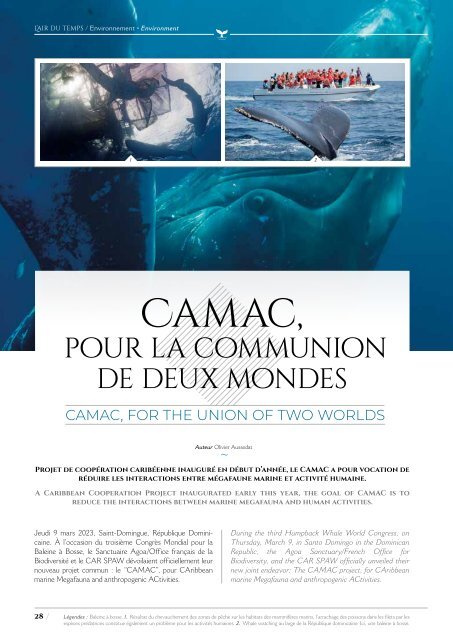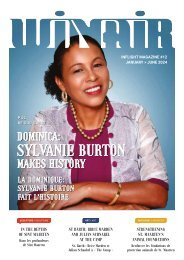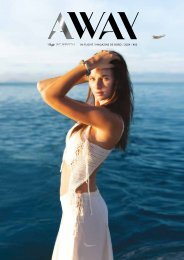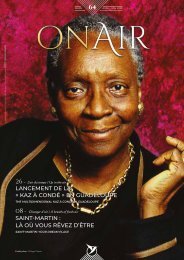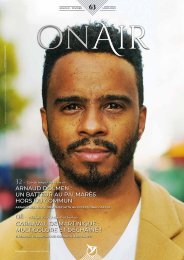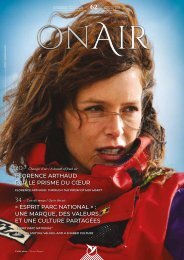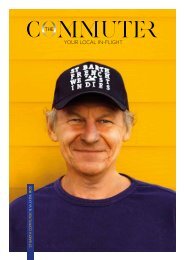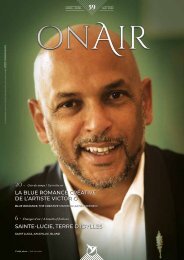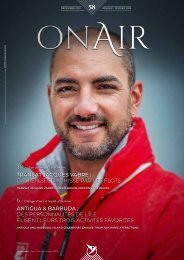ON AIR MAGAZINE #65
Create successful ePaper yourself
Turn your PDF publications into a flip-book with our unique Google optimized e-Paper software.
L’air du temps / Environnement • Environment<br />
Environnement • Environment / L’air du temps<br />
1 2<br />
Camac,<br />
pour la communion<br />
de deux mondes<br />
CAMAC, FOR THE UNI<strong>ON</strong> OF TWO WORLDS<br />
Auteur Olivier Aussedat<br />
~<br />
Projet de coopération caribéenne inauguré en début d’année, le CAMAC a pour vocation de<br />
réduire les interactions entre mégafaune marine et activité humaine.<br />
A Caribbean Cooperation Project inaugurated early this year, the goal of CAMAC is to<br />
reduce the interactions between marine megafauna and human activities.<br />
Une cérémonie de lancement marquée par la volonté des<br />
intervenant.e.s à s’engager séance tenante en faveur des<br />
mammifères marins du bassin Caraïbe, au travers de tables<br />
rondes de discussion. C’est ainsi que 32 représentants<br />
de 22 organisations et 12 pays (ou territoires) caribéens<br />
participèrent à ces ateliers de réflexion, au cours desquels<br />
furent approfondis 4 axes de travail thématiques. Prévu<br />
pour se dérouler sur cinq ans, le CAMAC entend en effet<br />
munir les institutions caribéennes et les<br />
acteurs pour l’environnement d’outils<br />
permettant de limiter les interactions<br />
négatives entre activités humaines et<br />
grands animaux marins de la Caraïbe.<br />
Pour se faire, le projet prévoit par<br />
exemple de renforcer les liens avec le<br />
secteur de la pêche — et en évaluer les<br />
interactions avec la mégafaune marine<br />
—, d’accroître ses connaissances des<br />
impacts sur ces animaux et de mieux<br />
définir leur répartition et concentration<br />
dans la région Caraïbe grâce à un<br />
inventaire régional. Le CAMAC<br />
prévoit enfin de sensibiliser à la<br />
préservation de la mégafaune marine<br />
et de renforcer les compétences en<br />
éducation à l’environnement.<br />
Vulnérable dans sa grande majorité, la<br />
population de mammifères marins de<br />
l’espace caribéen subit le plus souvent<br />
la présence, dans son milieu naturel,<br />
d’engins de pêche, d’activités touristiques<br />
(comme le whale-watching)<br />
ainsi que du trafic maritime. Alors<br />
que blessures graves et modifications<br />
du comportement sont couramment<br />
observées sur la faune concernée, ces<br />
interactions entre l’industrie et l’animal<br />
paralysent également certaines activités<br />
humaines : prises accidentelles,<br />
dégradation du matériel de pêche, etc.<br />
Le projet CAMAC s’inscrit donc dans<br />
une prise de conscience globale, celle<br />
de l’urgence d’améliorer nos connaissances sur les répercussions<br />
de nos interactions avec la nature et d’ainsi réduire<br />
l’impact de l’homme sur son environnement. Une initiative<br />
qui rayonne dans l’ensemble des Petites Antilles et jusqu’en<br />
Jamaïque, à Haïti ou le plateau des Guyanes, grâce en partie<br />
à un financement européen (FEDER) dans le cadre du programme<br />
Interreg Caraïbes.<br />
Un congrès<br />
venu de l’océan<br />
indien<br />
Tenu cette année pour la première<br />
fois dans la Caraïbe, le Congrès<br />
Mondial pour la Baleine à Bosse naît<br />
en 2015 à Madagascar. Mis en place<br />
par Cétamada, association malgache<br />
à but non lucratif, cet événement<br />
réunit de nombreux acteurs du milieu<br />
scientifique, public et étudiant pour<br />
le partage de connaissances autour<br />
de l’étude et la protection de la<br />
baleine à bosse.<br />
~<br />
A Congres Started<br />
In The Indian<br />
Ocean<br />
Held for the first time this year in<br />
the Caribbean, the Humpback<br />
Whale World Congress was born<br />
in Madagascar in 2015. Organized<br />
by Cétamada, a non-profit<br />
organization in Madagascar, this<br />
event unites numerous participants<br />
from the scientific community with<br />
the public and students to share<br />
knowledge about the study and<br />
protection of humpback whales.<br />
The inaugural ceremony illustrated the willingness of the<br />
various participants to commit to working together to<br />
protect marine mammals, starting with roundtables and<br />
discussions. As a result, 32 representatives of 22<br />
organizations and 12 Caribbean countries (or islands)<br />
participated in these think tanks, during which they<br />
examined four different thematic topics. Expected to<br />
extend over five years, CAMAC hopes to provide<br />
Caribbean governing bodies and<br />
environmental stakeholders with<br />
recommendations and tools to<br />
reduce the negative impact of<br />
interactions between marine<br />
megafauna and human activities. To<br />
do so, for example, the project plans<br />
to reinforce communication between<br />
the fishing industry — and evaluate<br />
its interactions with marine<br />
megafauna — increase knowledge<br />
about the impact on these animals,<br />
and better define their repartition<br />
and concentration in the Caribbean<br />
thanks to a regional inventory.<br />
CAMAC also plans to raise<br />
awareness about the conservation of<br />
marine megafauna and strengthen<br />
environmental education skills.<br />
Extremely vulnerable, marine<br />
mammals in their natural habitats in<br />
the Caribbean are often subject to<br />
fishing boats, tourism activities<br />
(such as whale-watching), and<br />
maritime traffic. As a result, serious<br />
injuries and behavioral modifications<br />
are frequently observed with this<br />
megafauna, and interactions<br />
between occupations and the animal<br />
can paralyze certain human activities<br />
as well: accidentally catching them,<br />
damage to fishing equipment, etc.<br />
The CAMAC project is part of a<br />
global effort representing urgency to<br />
improve our understanding of the repercussions caused<br />
by our interactions with nature, and to try and reduce the<br />
impact of mankind on the environment. This initiative<br />
has spread across the Lesser Antilles and as far as<br />
Jamaica and Haiti, as well as the Guiana plateau, thanks<br />
in part to European funding (FEDER) as part of the<br />
Caribbean Interreg program.<br />
Jeudi 9 mars 2023, Saint-Domingue, République Dominicaine.<br />
À l’occasion du troisième Congrès Mondial pour la<br />
Baleine à Bosse, le Sanctuaire Agoa/Office français de la<br />
Biodiversité et le CAR SPAW dévoilaient officiellement leur<br />
nouveau projet commun : le “CAMAC”, pour CAribbean<br />
marine Megafauna and anthropogenic ACtivities.<br />
During the third Humpback Whale World Congress, on<br />
Thursday, March 9, in Santo Domingo in the Dominican<br />
Republic, the Agoa Sanctuary/French Office for<br />
Biodiversity, and the CAR SPAW officially unveiled their<br />
new joint endeavor: The CAMAC project, for CAribbean<br />
marine Megafauna and anthropogenic ACtivities.<br />
PLUS D’INFORMATI<strong>ON</strong>S ~ MORE INFORMATI<strong>ON</strong><br />
https://sanctuaire-agoa.fr/editorial/camac<br />
https://sanctuaire-agoa.fr/editorial/lancement-du-projet-camac<br />
28<br />
Légendes : Baleine à bosse. 1. Résultat du chevauchement des zones de pêche sur les habitats des mammifères marins, l’arrachage des poissons dans les filets par les<br />
espèces prédatrices constitue également un problème pour les activités humaines. 2. Whale watching au large de la République dominicaine. Ici, une baleine à bosse.<br />
Crédit photos : © Shutterstock.<br />
onAir 65<br />
29


